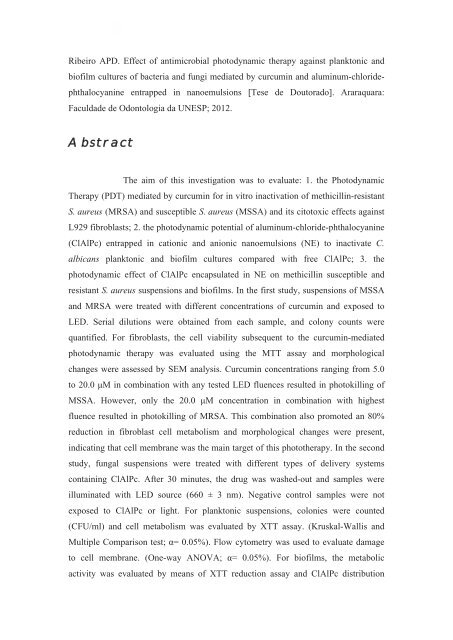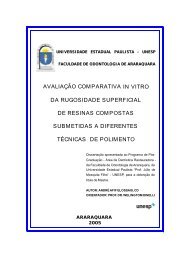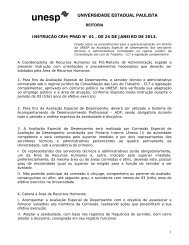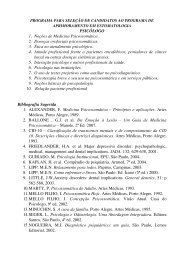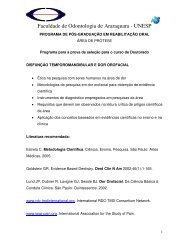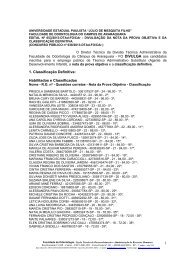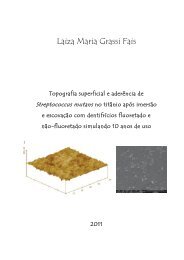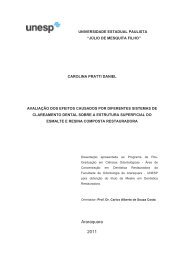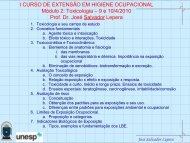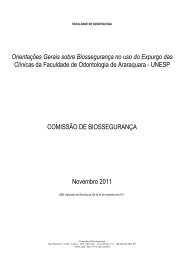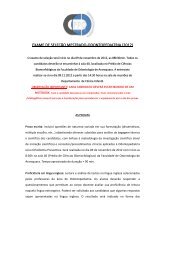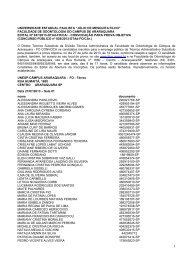Ana Paula Dias Ribeiro - Faculdade de Odontologia - Unesp
Ana Paula Dias Ribeiro - Faculdade de Odontologia - Unesp
Ana Paula Dias Ribeiro - Faculdade de Odontologia - Unesp
- No tags were found...
Create successful ePaper yourself
Turn your PDF publications into a flip-book with our unique Google optimized e-Paper software.
<strong>Ribeiro</strong> APD. Effect of antimicrobial photodynamic therapy against planktonic andbiofilm cultures of bacteria and fungi mediated by curcumin and aluminum-chlori<strong>de</strong>phthalocyanineentrapped in nanoemulsions [Tese <strong>de</strong> Doutorado]. Araraquara:<strong>Faculda<strong>de</strong></strong> <strong>de</strong> <strong>Odontologia</strong> da UNESP; 2012.AbstractThe aim of this investigation was to evaluate: 1. the PhotodynamicTherapy (PDT) mediated by curcumin for in vitro inactivation of methicillin-resistantS. aureus (MRSA) and susceptible S. aureus (MSSA) and its citotoxic effects againstL929 fibroblasts; 2. the photodynamic potential of aluminum-chlori<strong>de</strong>-phthalocyanine(ClAlPc) entrapped in cationic and anionic nanoemulsions (NE) to inactivate C.albicans planktonic and biofilm cultures compared with free ClAlPc; 3. thephotodynamic effect of ClAlPc encapsulated in NE on methicillin susceptible andresistant S. aureus suspensions and biofilms. In the first study, suspensions of MSSAand MRSA were treated with different concentrations of curcumin and exposed toLED. Serial dilutions were obtained from each sample, and colony counts werequantified. For fibroblasts, the cell viability subsequent to the curcumin-mediatedphotodynamic therapy was evaluated using the MTT assay and morphologicalchanges were assessed by SEM analysis. Curcumin concentrations ranging from 5.0to 20.0 μM in combination with any tested LED fluences resulted in photokilling ofMSSA. However, only the 20.0 μM concentration in combination with highestfluence resulted in photokilling of MRSA. This combination also promoted an 80%reduction in fibroblast cell metabolism and morphological changes were present,indicating that cell membrane was the main target of this phototherapy. In the secondstudy, fungal suspensions were treated with different types of <strong>de</strong>livery systemscontaining ClAlPc. After 30 minutes, the drug was washed-out and samples wereilluminated with LED source (660 ± 3 nm). Negative control samples were notexposed to ClAlPc or light. For planktonic suspensions, colonies were counted(CFU/ml) and cell metabolism was evaluated by XTT assay. (Kruskal-Wallis andMultiple Comparison test; α= 0.05%). Flow cytometry was used to evaluate damageto cell membrane. (One-way ANOVA; α= 0.05%). For biofilms, the metabolicactivity was evaluated by means of XTT reduction assay and ClAlPc distribution


